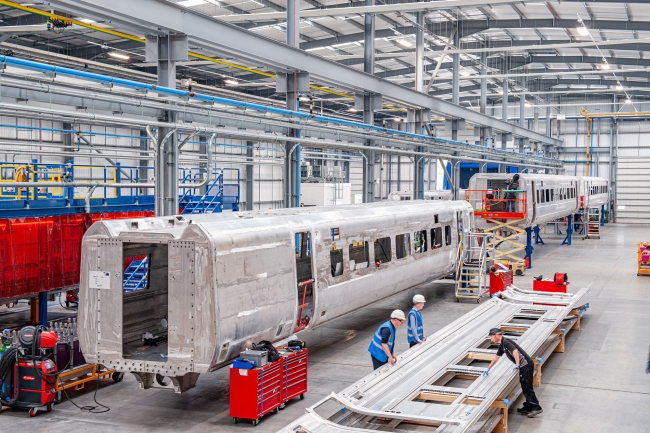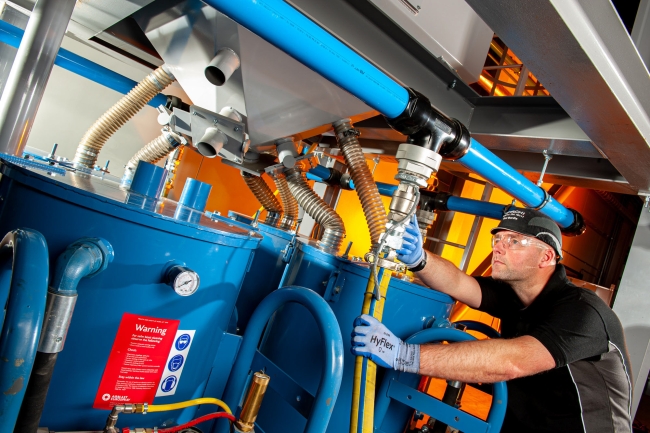4 minute read • published in partnership with Atlas Copco
Case Study: Atlas Copco plays vital role in Hitachi Rail’s new £8.5m welding and painting facility
Hitachi Rail has invested £8.5 million to create bespoke welding and painting facilities within its Newton Aycliffe factory, thereby extending its UK role from assembly-only to the complete fabrication and fit-out of units – the first time in decades that a new train welding facility of this type has been created in Britain. Atlas Copco’s successful bid for the design and installation of the 450metre compressed air and argon supply network has played an important role in the company’s on-shoring of crucial high-value aspects of its manufacturing process.
In 2015, Hitachi Rail’s £110 million investment established its highly advanced Northeast manufacturing base with a 700 strong workforce to build 122 pioneering trains as part of the UK government’s Intercity Express Programme, along with 70 zero-emission Class 385 regional trains for Scotland.
The new welding and painting facility now allows Hitachi Rail to complete the build of the high-tech aluminium carriage shells of the next generation of intercity trains for East Midlands Railway and Avanti West.

Picture: Atlas Copco
Hitachi Rail facilities manager, Colin Trevor, said “We can now design, fabricate, paint, assemble and test trains at this facility, allowing us to be more globally competitive, with the capacity to build a wide range of products, from metros to commuter and high-speed trains”.
The new welding and painting production plant is installed within a 194 x 40 metre warehouse conversion adjacent to the main assembly area. This development came with a requirement for a compressed air supply for painting operations and an argon gas feed for the TIG welding workstations.
Wearside Pneumatics, Atlas Copco Compressors’ Gateshead-based premier distributor, was called upon to produce the design, specify the pipework system, and to carry out the installation of dual ring mains to link the air and gas supplies from the existing assembly plant to the new production workstations.
The recommendation to Hitachi Rail’s production management was twofold: Firstly, a 100mm diameter aluminium 180 x 40 metre ring main to deliver 7bar compressed air at the rate of 474 l/s (1705m3h) to 40 drops within the weld operation area. In parallel with the air requirement, the argon supply structure to feed the welding workstations would comprise a 35mm stainless-steel ring main designed to deliver gas at 7bar pressure, at a flow rate of 20l/s (71 m3h), direct to 40 drops within the TIG welding process area.
Furthermore, Wearside Pneumatics would also install a Unistrut channel containment at a height of nine metres, sited between the plant’s overhead crane system and the factory roof space.
The whole project required close coordination with the timing and progress of the new facility’s capital plant installations and was completed over a total period of twelve months.
Although galvanised steel compressed air pipework has been the industry standard for many years, major industry players worldwide like Hitachi Rail are replacing it with Atlas Copco’s AIRnet – a lightweight, durable aluminium/polymer component network which, by minimising pressure drop penalties, contributes substantially to energy savings, air quality and production efficiency.

Picture: Atlas Copco
Steel pipe is heavy, its threaded joints require careful preparation, and its inner surfaces are not smooth. As a result, this restricts flow and promotes pressure drop, which equates to energy loss.
In contrast, Atlas Copco’s AIRnet lightweight, highly durable modular network system of corrosion-resistant aluminium pipes, together with self-aligning, fully sealed polymer fittings with integrated O-rings, eliminates the possibility of costly leaks – and they can be significant. A pressure drop of 1 bar can result in a 7% increase in energy consumption.
Size for size, AIRnet pipework, constructed in ISO 8573-1certified 1:2:0 class aluminium, weighs 5 times less than its steel equivalent. It is extremely robust and quick and easy to install. Fitting the pipework takes about one third of the time compared to that for a conventional system. Also, there is no time-consuming screw cutting and no need for any special tools or lifting equipment. AIRnet pipes can be simply pushed into the polymer fitting, tightened by hand and secured with a spanner. When the aluminium AIRnet pipe is cut to size, there is no risk of corrosion of the exposed metal and thus no risk of leakage.

Picture: Atlas Copco
The AIRnet system offers pipework with smooth, anodised internal surfaces as standard, which minimises pressure drop penalties and performs a vital role in ensuring that the air supply is kept clean to protect downstream equipment and sensitive production processes. Furthermore, the piping system can be connected to any existing network and can be modified easily to meet any changes on the industrial floor layout. AIRnet answers these needs with a wide range of interchangeable and reusable fittings designed to support upgrades in layout and capacity.
In the same way as the AIRnet aluminium compressed air network, the new fabrication area’s 35mm argon supply ring main is constructed in EN10088 standard stainless steel with push fit connection to achieve a non-corrosive, durable system that does not affect the quality of the gases transported. This minimises maintenance costs and the costs related to protection of downstream equipment, processes, and applications. The system is conceived to offer high performance over decades that assists in achieving strict quality control within production operations.
With regard to Atlas Copco’s product standards and overall progress with the AIRnet pipework installation process, Colin Trevor, said: “The company’s co-operation and timing, plus the product quality, performance and productivity benefits of the Atlas Copco pipework system installation has contributed substantially to the success of this project”.
